Sato, F; Moreira, AS; Bettini, J; Coura, PZ; Dantas, SO; Ugarte, D; Galvao, DS
On the Formation of Copper Linear Atomic Suspended Chains Journal Article
In: arXiv preprint cond-mat/0602092, 2006.
@article{sato2006formation,
title = {On the Formation of Copper Linear Atomic Suspended Chains},
author = {Sato, F and Moreira, AS and Bettini, J and Coura, PZ and Dantas, SO and Ugarte, D and Galvao, DS},
url = {http://arxiv.org/abs/cond-mat/0602092},
year = {2006},
date = {2006-01-01},
journal = {arXiv preprint cond-mat/0602092},
abstract = {We report high resolution transmission electron microscopy and classical molecular dynamics simulation results of mechanically stretching copper nanowires conducting to linear atomic suspended chains (LACs) formation. In contrast with some previous experimental and theoretical work in literature that stated that the formation of LACs for copper should not exist our results showed the existence of LAC for the [111], [110], and [100] crystallographic directions, being thus the sequence of most probable occurence.},
keywords = {},
pubstate = {published},
tppubtype = {article}
}
Sato, F; Moreira, AS; Bettini, J; Coura, PZ; Dantas, SO; Ugarte, D; Galvao, DS
Transmission electron microscopy and molecular dynamics study of the formation of suspended copper linear atomic chains Journal Article
In: Physical Review-Section B-Condensed Matter, vol. 74, no. 19, pp. 193401–193401, 2006.
@article{sato2006surface,
title = {Transmission electron microscopy and molecular dynamics study of the formation of suspended copper linear atomic chains},
author = {Sato, F and Moreira, AS and Bettini, J and Coura, PZ and Dantas, SO and Ugarte, D and Galvao, DS},
url = {http://journals.aps.org/prb/abstract/10.1103/PhysRevB.74.193401},
year = {2006},
date = {2006-01-01},
journal = {Physical Review-Section B-Condensed Matter},
volume = {74},
number = {19},
pages = {193401--193401},
publisher = {Woodbury, NY: published by the American Physical Society through the American Institute of Physics, c1998-},
abstract = {We report high-resolution transmission electron microscopy and molecular dynamics simulation results of mechanically stretching nanowires leading to linear atomic suspended chain (LAC) formation. In contrast with some previous experimental and theoretical works in the literature that stated that the formation of LAC’s for copper should be unlikely our results showed the existence of LAC’s for the [111], [110], and [100] crystallographic directions, being thus the sequence of most probable occurrence. Our results clearly indicate that temperture and pulling velocity, associated with internal stress, are fundamental aspects to determine LAC formation.},
keywords = {},
pubstate = {published},
tppubtype = {article}
}
Sato, F; Moreira, AS; Coura, PZ; Dantas, SO; Legoas, SB; Ugarte, D; Galvao, DS
Computer simulations of gold nanowire formation: the role of outlayer atoms Journal Article
In: Applied Physics A (invited paper), vol. 81, no. 8, pp. 1527–1531, 2005.
@article{sato2005computer,
title = {Computer simulations of gold nanowire formation: the role of outlayer atoms},
author = {Sato, F and Moreira, AS and Coura, PZ and Dantas, SO and Legoas, SB and Ugarte, D and Galvao, DS},
url = {http://link.springer.com/article/10.1007/s00339-005-3390-2},
year = {2005},
date = {2005-01-01},
journal = {Applied Physics A (invited paper)},
volume = {81},
number = {8},
pages = {1527--1531},
publisher = {Springer-Verlag},
abstract = {Metallic nanowires (NWs) have been the object of intense theoretical and experimental investigations in the last years. In this work we present and review a new methodology we developed to study NW formation from mechanical stretching. This methodology is based on tight-binding molecular dynamics techniques using second-moment approximations. This methodology had been proven to be very effective in the study of NWs, reliably reproducing the main experimentally observed structural features. We have also investigated the problem of determining from what regions the atoms composing the linear atomic chains come. Our results show that ∼90% of these atoms come from outmost external layers.
},
keywords = {},
pubstate = {published},
tppubtype = {article}
}
Legoas, SB; Rodrigues, V; Ugarte, D; Galvao, DS
Legoas et al. Reply Journal Article
In: Physical Review Letters, vol. 95, no. 16, pp. 169602, 2005.
@article{legoas2005legoas,
title = {Legoas et al. Reply},
author = {Legoas, SB and Rodrigues, V and Ugarte, D and Galvao, DS},
url = {http://journals.aps.org/prl/abstract/10.1103/PhysRevLett.95.169602},
year = {2005},
date = {2005-01-01},
journal = {Physical Review Letters},
volume = {95},
number = {16},
pages = {169602},
keywords = {},
pubstate = {published},
tppubtype = {article}
}
Legoas, Sergio B; Rodrigues, Varlei; Ugarte, Daniel; Galvao, Douglas S
Contaminants in suspended gold chains: An ab initio molecular dynamics study Journal Article
In: Physical Review Letters, vol. 93, no. 21, pp. 216103, 2004.
@article{legoas2004contaminants,
title = {Contaminants in suspended gold chains: An ab initio molecular dynamics study},
author = {Legoas, Sergio B and Rodrigues, Varlei and Ugarte, Daniel and Galvao, Douglas S},
url = {http://journals.aps.org/prl/abstract/10.1103/PhysRevLett.93.216103},
year = {2004},
date = {2004-01-01},
journal = {Physical Review Letters},
volume = {93},
number = {21},
pages = {216103},
publisher = {American Physical Society},
abstract = {Recently, we have proposed that the origin of anomalously long interatomic distances in suspended gold chains could be the result of carbon contamination during sample manipulation [S. B. Legoas et al., Phys. Rev. Lett. 88, 076105 (2002)]. More recently, however, other works have proposed that hydrogen instead of carbon should be the most probable contaminant. We report ab initio molecular dynamics results for different temperatures considering different possible contaminants. Our results show that at nonzero temperatures (more realistic to simulate the experimental conditions) hydrogen may be ruled out and carbon atoms remain the best candidate for contamination.},
keywords = {},
pubstate = {published},
tppubtype = {article}
}
Gonzalez, JC; Rodrigues, V; Bettini, J; Rego, LGC; Rocha, AR; Coura, PZ; Dantas, SO; Sato, F; Galvao, DS; Ugarte, D
Indication of unusual pentagonal structures in atomic-size Cu nanowires Journal Article
In: Physical Review Letters, vol. 93, no. 12, pp. 126103, 2004.
@article{gonzalez2004indication,
title = {Indication of unusual pentagonal structures in atomic-size Cu nanowires},
author = {Gonzalez, JC and Rodrigues, V and Bettini, J and Rego, LGC and Rocha, AR and Coura, PZ and Dantas, SO and Sato, F and Galvao, DS and Ugarte, D},
url = {http://journals.aps.org/prl/abstract/10.1103/PhysRevLett.93.126103},
year = {2004},
date = {2004-01-01},
journal = {Physical Review Letters},
volume = {93},
number = {12},
pages = {126103},
publisher = {APS},
abstract = {We present a study of the structural and quantum conductance properties of atomic-size copper nanowires generated by mechanical stretching. The atomistic evolution was derived from time-resolved electron microscopy observations and molecular dynamics simulations. We have analyzed the quantum transport behavior by means of conductance measurements and theoretical calculations. The results suggest the formation of an unusual and highly stable pentagonal Cu nanowire with a diameter of ∼0.45 nm and ∼4.5 conductance quanta.
},
keywords = {},
pubstate = {published},
tppubtype = {article}
}
Galvao, Douglas Soares; Rodrigues, Varlei; Ugarte, Daniel; Legoas, Sergio Benites
The role of carbon contamination in metallic nanowires Journal Article
In: Materials Research, vol. 7, no. 2, pp. 339–342, 2004.
@article{galvao2004role,
title = {The role of carbon contamination in metallic nanowires},
author = {Galvao, Douglas Soares and Rodrigues, Varlei and Ugarte, Daniel and Legoas, Sergio Benites},
url = {http://www.scielo.br/scielo.php?pid=S1516-14392004000200020&script=sci_arttext},
year = {2004},
date = {2004-01-01},
journal = {Materials Research},
volume = {7},
number = {2},
pages = {339--342},
publisher = {SciELO Brasil},
abstract = {Metallic nanowires have attracted much attention in the last years due to new phenomena such as quantum conductance and the existence of unexpected long interatomic distances attaining 0.3-0.5 nm. These large distances represented a challenge for physical interpretation. In this work we present experimental data from high-resolution transmission electron microscopy and results from ab initio calculations for suspended gold chains and show that these large distances can be easily explained by the presence of carbon atoms as contaminants. In principle the present conclusions can be also applied to other metallic nanowires (such as Ag and Pt) whose structures also present large interatomic distances.},
keywords = {},
pubstate = {published},
tppubtype = {article}
}
Legoas, Sergio B; Galvao, Douglas S; Rodrigues, Varlei; Ugarte, Daniel
Origin of anomalously long interatomic distances in suspended gold chains Journal Article
In: Physical Review Letters, vol. 88, no. 7, pp. 076105, 2002.
@article{legoas2002origin,
title = {Origin of anomalously long interatomic distances in suspended gold chains},
author = {Legoas, Sergio B and Galvao, Douglas S and Rodrigues, Varlei and Ugarte, Daniel},
url = {http://journals.aps.org/prl/abstract/10.1103/PhysRevLett.88.076105},
year = {2002},
date = {2002-01-01},
journal = {Physical Review Letters},
volume = {88},
number = {7},
pages = {076105},
publisher = {American Physical Society},
abstract = {The discovery of long bonds in gold atom chains has represented a challenge for physical interpretation. In fact, interatomic distances frequently attain 3.0–3.6 Å values, and distances as large as 5.0 Å may be occasionally observed. Here we studied gold chains by transmission electron microscopy and performed theoretical calculations using cluster ab initio density functional formalism. We show that the insertion of two carbon atoms is required to account for the longest bonds, while distances above 3 Å may be due to a mixture of clean and one C atom contaminated bonds.},
keywords = {},
pubstate = {published},
tppubtype = {article}
}
Legoas, Sergio B; Galvao, Douglas S; Rodrigues, Varlei; Ugarte, Daniel
The Role of Carbon Contamination in Suspended Gold Nanowires Journal Article
In: MRS Proceedings, vol. 738, pp. G14–6, 2002.
@article{legoas2002role,
title = {The Role of Carbon Contamination in Suspended Gold Nanowires},
author = {Legoas, Sergio B and Galvao, Douglas S and Rodrigues, Varlei and Ugarte, Daniel},
url = {http://journals.cambridge.org/action/displayAbstract?fromPage=online&aid=8031754&fileId=S1946427400148249},
year = {2002},
date = {2002-01-01},
journal = {MRS Proceedings},
volume = {738},
pages = {G14--6},
publisher = {Cambridge University Press},
abstract = {Metallic nanowires represent very interesting systems due to new phenomena such as quantum conductance and unexpected long interatomic distances attaining 0.3–0.5 nm. These large distances represent a challenge for physical interpretation. In this work we present experimental data from transmission electron microscopy and results from ab initio density functional calculations for suspended gold chains. We show that large distances as 0.5 nm can be easily explained by the presence of carbon atoms as contaminants, while distances ranging from 0.29 up to 0.36 nm might be explained as resulting of a mixture of clean stressed and contaminated linear chains.},
keywords = {},
pubstate = {published},
tppubtype = {article}
}
2006
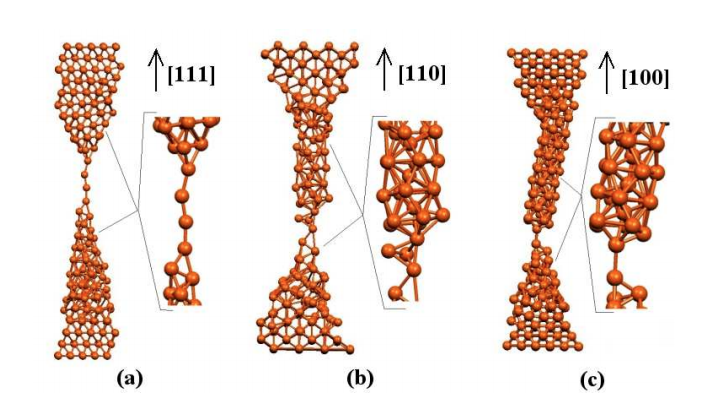
Sato, F; Moreira, AS; Bettini, J; Coura, PZ; Dantas, SO; Ugarte, D; Galvao, DS
On the Formation of Copper Linear Atomic Suspended Chains Journal Article
In: arXiv preprint cond-mat/0602092, 2006.
Abstract | Links | BibTeX | Tags: Copper, Linear Atomic Chains, Metallic Nanowires, Molecular Dynamics, TEM
@article{sato2006formation,
title = {On the Formation of Copper Linear Atomic Suspended Chains},
author = {Sato, F and Moreira, AS and Bettini, J and Coura, PZ and Dantas, SO and Ugarte, D and Galvao, DS},
url = {http://arxiv.org/abs/cond-mat/0602092},
year = {2006},
date = {2006-01-01},
journal = {arXiv preprint cond-mat/0602092},
abstract = {We report high resolution transmission electron microscopy and classical molecular dynamics simulation results of mechanically stretching copper nanowires conducting to linear atomic suspended chains (LACs) formation. In contrast with some previous experimental and theoretical work in literature that stated that the formation of LACs for copper should not exist our results showed the existence of LAC for the [111], [110], and [100] crystallographic directions, being thus the sequence of most probable occurence.},
keywords = {Copper, Linear Atomic Chains, Metallic Nanowires, Molecular Dynamics, TEM},
pubstate = {published},
tppubtype = {article}
}
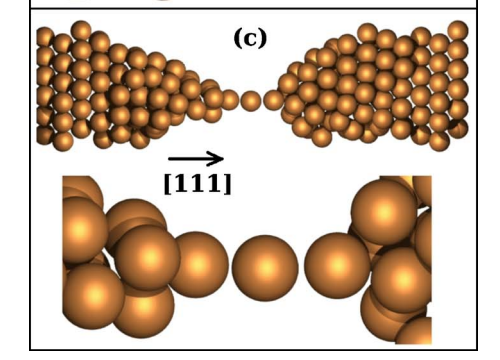
Sato, F; Moreira, AS; Bettini, J; Coura, PZ; Dantas, SO; Ugarte, D; Galvao, DS
Transmission electron microscopy and molecular dynamics study of the formation of suspended copper linear atomic chains Journal Article
In: Physical Review-Section B-Condensed Matter, vol. 74, no. 19, pp. 193401–193401, 2006.
Abstract | Links | BibTeX | Tags: Linear Atomic Chains, Metallic Nanowires, Molecular Dynamics, TEM
@article{sato2006surface,
title = {Transmission electron microscopy and molecular dynamics study of the formation of suspended copper linear atomic chains},
author = {Sato, F and Moreira, AS and Bettini, J and Coura, PZ and Dantas, SO and Ugarte, D and Galvao, DS},
url = {http://journals.aps.org/prb/abstract/10.1103/PhysRevB.74.193401},
year = {2006},
date = {2006-01-01},
journal = {Physical Review-Section B-Condensed Matter},
volume = {74},
number = {19},
pages = {193401--193401},
publisher = {Woodbury, NY: published by the American Physical Society through the American Institute of Physics, c1998-},
abstract = {We report high-resolution transmission electron microscopy and molecular dynamics simulation results of mechanically stretching nanowires leading to linear atomic suspended chain (LAC) formation. In contrast with some previous experimental and theoretical works in the literature that stated that the formation of LAC’s for copper should be unlikely our results showed the existence of LAC’s for the [111], [110], and [100] crystallographic directions, being thus the sequence of most probable occurrence. Our results clearly indicate that temperture and pulling velocity, associated with internal stress, are fundamental aspects to determine LAC formation.},
keywords = {Linear Atomic Chains, Metallic Nanowires, Molecular Dynamics, TEM},
pubstate = {published},
tppubtype = {article}
}
2005
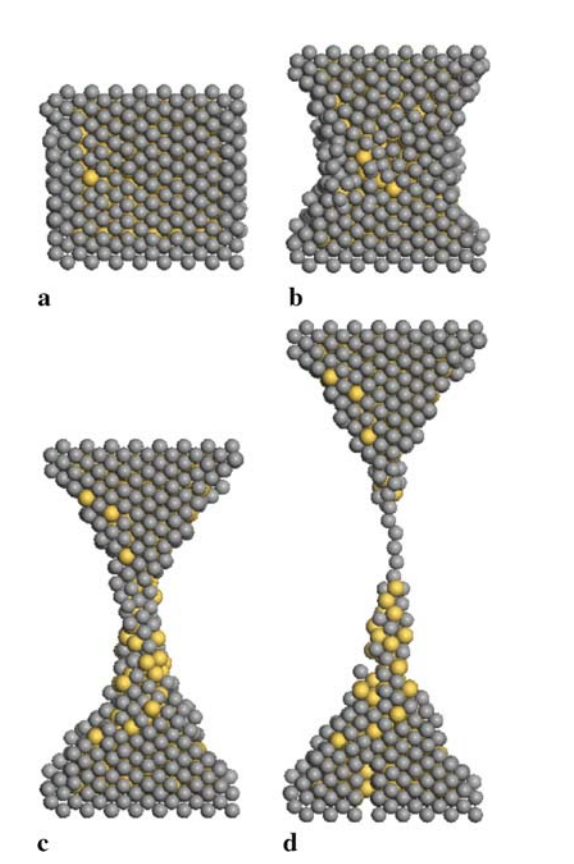
Sato, F; Moreira, AS; Coura, PZ; Dantas, SO; Legoas, SB; Ugarte, D; Galvao, DS
Computer simulations of gold nanowire formation: the role of outlayer atoms Journal Article
In: Applied Physics A (invited paper), vol. 81, no. 8, pp. 1527–1531, 2005.
Abstract | Links | BibTeX | Tags: Linear Atomic Chains, Metallic Nanowires, Molecular Dynamics, TEM
@article{sato2005computer,
title = {Computer simulations of gold nanowire formation: the role of outlayer atoms},
author = {Sato, F and Moreira, AS and Coura, PZ and Dantas, SO and Legoas, SB and Ugarte, D and Galvao, DS},
url = {http://link.springer.com/article/10.1007/s00339-005-3390-2},
year = {2005},
date = {2005-01-01},
journal = {Applied Physics A (invited paper)},
volume = {81},
number = {8},
pages = {1527--1531},
publisher = {Springer-Verlag},
abstract = {Metallic nanowires (NWs) have been the object of intense theoretical and experimental investigations in the last years. In this work we present and review a new methodology we developed to study NW formation from mechanical stretching. This methodology is based on tight-binding molecular dynamics techniques using second-moment approximations. This methodology had been proven to be very effective in the study of NWs, reliably reproducing the main experimentally observed structural features. We have also investigated the problem of determining from what regions the atoms composing the linear atomic chains come. Our results show that ∼90% of these atoms come from outmost external layers.
},
keywords = {Linear Atomic Chains, Metallic Nanowires, Molecular Dynamics, TEM},
pubstate = {published},
tppubtype = {article}
}
Legoas, SB; Rodrigues, V; Ugarte, D; Galvao, DS
Legoas et al. Reply Journal Article
In: Physical Review Letters, vol. 95, no. 16, pp. 169602, 2005.
Links | BibTeX | Tags: Linear Atomic Chains, Metallic Nanowires, Molecular Dynamics
@article{legoas2005legoas,
title = {Legoas et al. Reply},
author = {Legoas, SB and Rodrigues, V and Ugarte, D and Galvao, DS},
url = {http://journals.aps.org/prl/abstract/10.1103/PhysRevLett.95.169602},
year = {2005},
date = {2005-01-01},
journal = {Physical Review Letters},
volume = {95},
number = {16},
pages = {169602},
keywords = {Linear Atomic Chains, Metallic Nanowires, Molecular Dynamics},
pubstate = {published},
tppubtype = {article}
}
2004
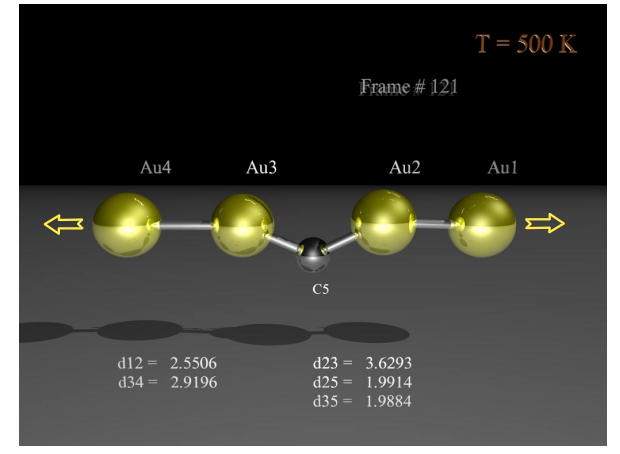
Legoas, Sergio B; Rodrigues, Varlei; Ugarte, Daniel; Galvao, Douglas S
Contaminants in suspended gold chains: An ab initio molecular dynamics study Journal Article
In: Physical Review Letters, vol. 93, no. 21, pp. 216103, 2004.
Abstract | Links | BibTeX | Tags: DFT, Electronic Structure, Linear Atomic Chains, Metallic Nanowires, top20
@article{legoas2004contaminants,
title = {Contaminants in suspended gold chains: An ab initio molecular dynamics study},
author = {Legoas, Sergio B and Rodrigues, Varlei and Ugarte, Daniel and Galvao, Douglas S},
url = {http://journals.aps.org/prl/abstract/10.1103/PhysRevLett.93.216103},
year = {2004},
date = {2004-01-01},
journal = {Physical Review Letters},
volume = {93},
number = {21},
pages = {216103},
publisher = {American Physical Society},
abstract = {Recently, we have proposed that the origin of anomalously long interatomic distances in suspended gold chains could be the result of carbon contamination during sample manipulation [S. B. Legoas et al., Phys. Rev. Lett. 88, 076105 (2002)]. More recently, however, other works have proposed that hydrogen instead of carbon should be the most probable contaminant. We report ab initio molecular dynamics results for different temperatures considering different possible contaminants. Our results show that at nonzero temperatures (more realistic to simulate the experimental conditions) hydrogen may be ruled out and carbon atoms remain the best candidate for contamination.},
keywords = {DFT, Electronic Structure, Linear Atomic Chains, Metallic Nanowires, top20},
pubstate = {published},
tppubtype = {article}
}
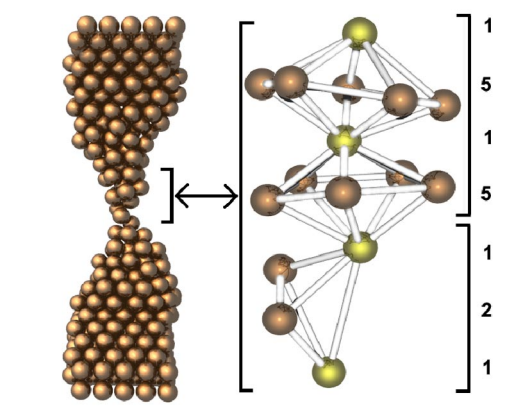
Gonzalez, JC; Rodrigues, V; Bettini, J; Rego, LGC; Rocha, AR; Coura, PZ; Dantas, SO; Sato, F; Galvao, DS; Ugarte, D
Indication of unusual pentagonal structures in atomic-size Cu nanowires Journal Article
In: Physical Review Letters, vol. 93, no. 12, pp. 126103, 2004.
Abstract | Links | BibTeX | Tags: Copper Nanowires, Linear Atomic Chains, Metallic Nanowires, Molecular Dynamics, TEM, top20
@article{gonzalez2004indication,
title = {Indication of unusual pentagonal structures in atomic-size Cu nanowires},
author = {Gonzalez, JC and Rodrigues, V and Bettini, J and Rego, LGC and Rocha, AR and Coura, PZ and Dantas, SO and Sato, F and Galvao, DS and Ugarte, D},
url = {http://journals.aps.org/prl/abstract/10.1103/PhysRevLett.93.126103},
year = {2004},
date = {2004-01-01},
journal = {Physical Review Letters},
volume = {93},
number = {12},
pages = {126103},
publisher = {APS},
abstract = {We present a study of the structural and quantum conductance properties of atomic-size copper nanowires generated by mechanical stretching. The atomistic evolution was derived from time-resolved electron microscopy observations and molecular dynamics simulations. We have analyzed the quantum transport behavior by means of conductance measurements and theoretical calculations. The results suggest the formation of an unusual and highly stable pentagonal Cu nanowire with a diameter of ∼0.45 nm and ∼4.5 conductance quanta.
},
keywords = {Copper Nanowires, Linear Atomic Chains, Metallic Nanowires, Molecular Dynamics, TEM, top20},
pubstate = {published},
tppubtype = {article}
}
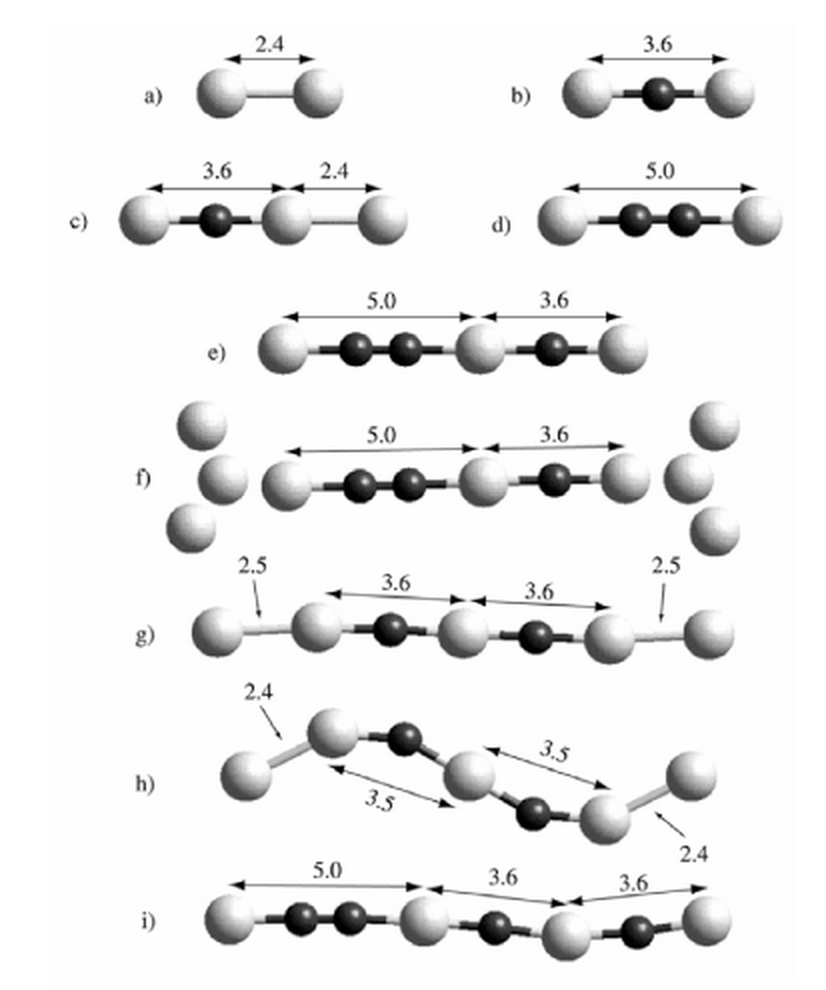
Galvao, Douglas Soares; Rodrigues, Varlei; Ugarte, Daniel; Legoas, Sergio Benites
The role of carbon contamination in metallic nanowires Journal Article
In: Materials Research, vol. 7, no. 2, pp. 339–342, 2004.
Abstract | Links | BibTeX | Tags: Contaminantes, Electronic Structure, Linear Atomic Chains, Metallic Nanowires, Structure
@article{galvao2004role,
title = {The role of carbon contamination in metallic nanowires},
author = {Galvao, Douglas Soares and Rodrigues, Varlei and Ugarte, Daniel and Legoas, Sergio Benites},
url = {http://www.scielo.br/scielo.php?pid=S1516-14392004000200020&script=sci_arttext},
year = {2004},
date = {2004-01-01},
journal = {Materials Research},
volume = {7},
number = {2},
pages = {339--342},
publisher = {SciELO Brasil},
abstract = {Metallic nanowires have attracted much attention in the last years due to new phenomena such as quantum conductance and the existence of unexpected long interatomic distances attaining 0.3-0.5 nm. These large distances represented a challenge for physical interpretation. In this work we present experimental data from high-resolution transmission electron microscopy and results from ab initio calculations for suspended gold chains and show that these large distances can be easily explained by the presence of carbon atoms as contaminants. In principle the present conclusions can be also applied to other metallic nanowires (such as Ag and Pt) whose structures also present large interatomic distances.},
keywords = {Contaminantes, Electronic Structure, Linear Atomic Chains, Metallic Nanowires, Structure},
pubstate = {published},
tppubtype = {article}
}
2002
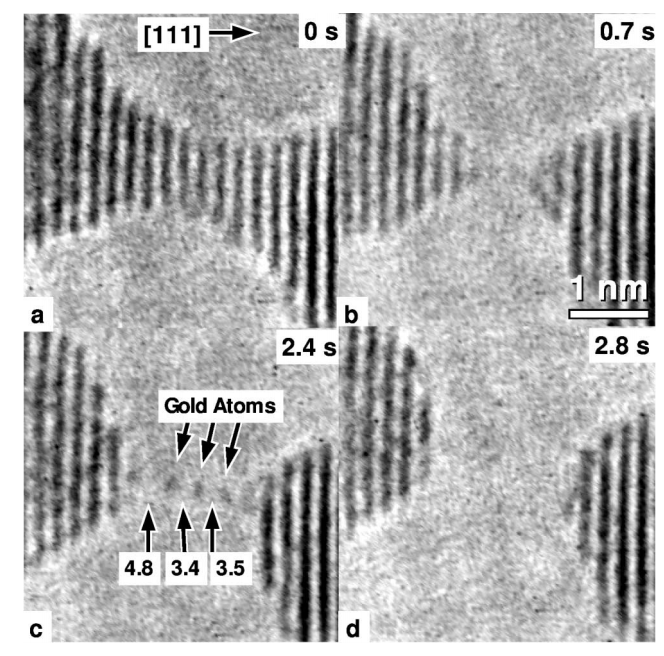
Legoas, Sergio B; Galvao, Douglas S; Rodrigues, Varlei; Ugarte, Daniel
Origin of anomalously long interatomic distances in suspended gold chains Journal Article
In: Physical Review Letters, vol. 88, no. 7, pp. 076105, 2002.
Abstract | Links | BibTeX | Tags: DFT, Electronic Structure, Linear Atomic Chains, Metallic Nanowires, TEM, top20
@article{legoas2002origin,
title = {Origin of anomalously long interatomic distances in suspended gold chains},
author = {Legoas, Sergio B and Galvao, Douglas S and Rodrigues, Varlei and Ugarte, Daniel},
url = {http://journals.aps.org/prl/abstract/10.1103/PhysRevLett.88.076105},
year = {2002},
date = {2002-01-01},
journal = {Physical Review Letters},
volume = {88},
number = {7},
pages = {076105},
publisher = {American Physical Society},
abstract = {The discovery of long bonds in gold atom chains has represented a challenge for physical interpretation. In fact, interatomic distances frequently attain 3.0–3.6 Å values, and distances as large as 5.0 Å may be occasionally observed. Here we studied gold chains by transmission electron microscopy and performed theoretical calculations using cluster ab initio density functional formalism. We show that the insertion of two carbon atoms is required to account for the longest bonds, while distances above 3 Å may be due to a mixture of clean and one C atom contaminated bonds.},
keywords = {DFT, Electronic Structure, Linear Atomic Chains, Metallic Nanowires, TEM, top20},
pubstate = {published},
tppubtype = {article}
}
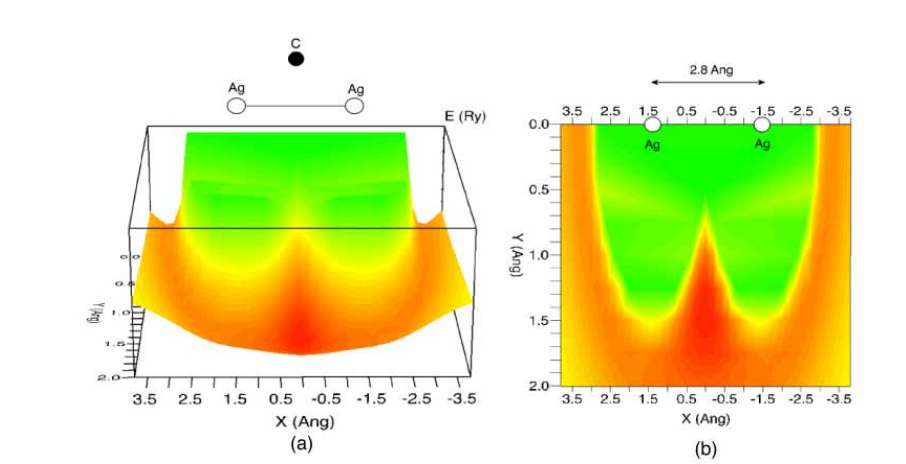
Legoas, Sergio B; Galvao, Douglas S; Rodrigues, Varlei; Ugarte, Daniel
The Role of Carbon Contamination in Suspended Gold Nanowires Journal Article
In: MRS Proceedings, vol. 738, pp. G14–6, 2002.
Abstract | Links | BibTeX | Tags: DFT, Electronic Structure, Linear Atomic Chains, Metallic Nanowires, TEM
@article{legoas2002role,
title = {The Role of Carbon Contamination in Suspended Gold Nanowires},
author = {Legoas, Sergio B and Galvao, Douglas S and Rodrigues, Varlei and Ugarte, Daniel},
url = {http://journals.cambridge.org/action/displayAbstract?fromPage=online&aid=8031754&fileId=S1946427400148249},
year = {2002},
date = {2002-01-01},
journal = {MRS Proceedings},
volume = {738},
pages = {G14--6},
publisher = {Cambridge University Press},
abstract = {Metallic nanowires represent very interesting systems due to new phenomena such as quantum conductance and unexpected long interatomic distances attaining 0.3–0.5 nm. These large distances represent a challenge for physical interpretation. In this work we present experimental data from transmission electron microscopy and results from ab initio density functional calculations for suspended gold chains. We show that large distances as 0.5 nm can be easily explained by the presence of carbon atoms as contaminants, while distances ranging from 0.29 up to 0.36 nm might be explained as resulting of a mixture of clean stressed and contaminated linear chains.},
keywords = {DFT, Electronic Structure, Linear Atomic Chains, Metallic Nanowires, TEM},
pubstate = {published},
tppubtype = {article}
}
http://scholar.google.com/citations?hl=en&user=95SvbM8AAAAJ


